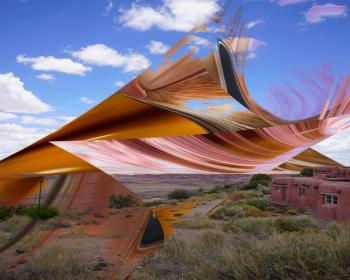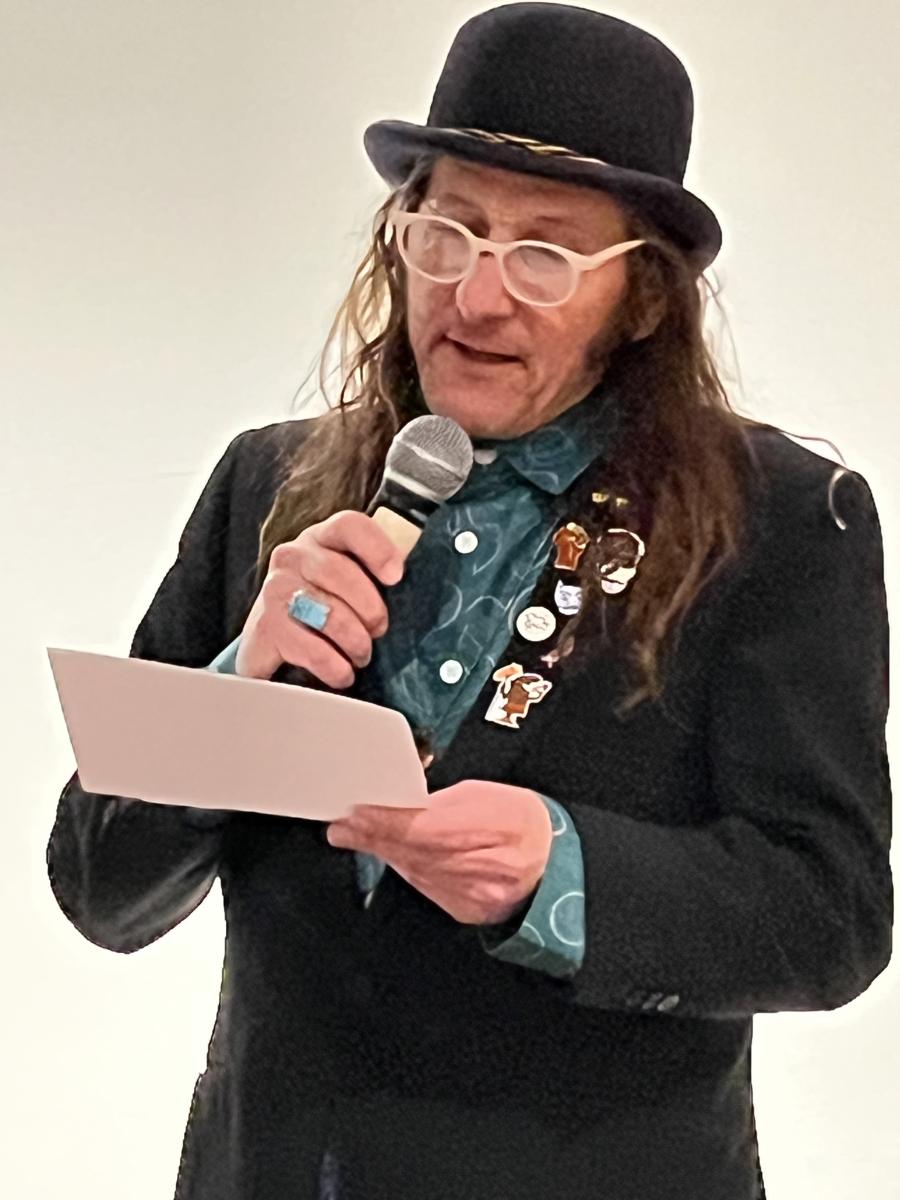Native Americans in the United States are using radio to preserve traditional languages and cultures. For years, electronic mass media were seen as villains in the struggle to preserve indigenous cultures in the U.S. Distant radio and television signals bombarded indigenous communities, overwhelming fragile languages and cultures. Native American children listened to Western radio and television and often adopted the English language and Western culture as their own, threatening the very survival of their own traditional languages and practices.
Today, Native Americans are taking greater control of the electronic media that reach their communities by operating radio and television facilities of their own. As a result, media are becoming allies in their struggle for cultural survival. While some communities are making use of television, radio is the medium that is making the greatest advances, largely because it is comparatively inexpensive to start and operate.
Gordon Regguinti, Executive Director of Native American Journalists Association (NAJA), calls Native American radio "an electronic smoke signal, a modern version of the smoke signals that allowed Indians to communicate over long distances in times past." Regguinti enthusiastically supports Native American use of radio today: "Radio is one of the least expensive ways to reach [indigenous] people and to set up a dialogue so those people will have a voice."
Not a Passing Fad
Tim Giago, publisher of the national newspaper, Indian Country Today, speculated in 1980 that seeking access to electronic media was not a passing fad for Native Americans. It was, he said, a means of survival:
"Indians see the acquisition of such access as a struggle for survival. The tribes are simply fed up with the lack of service provided by the mass media and the stereotyping such access and misrepresentation that is prevalent in the media. They are clamoring for a voice, literally and figuratively."
In the nearly two decades since he wrote that, Native Americans in South Dakota, where Giago lives, have increased the number of radio stations they own from one to four. Across the U.S., the number of Native American stations has nearly tripled from 11 to 32. Each year, additional stations are going on the air and today, a large percentage of Native Americans live within the coverage area of a Native American radio station.
Supporting the Oral Tradition
The particular value of radio, according to Regguinti, is that it is an oral medium that fits with the oral traditions of Native peoples. Meg Quintal, a staff member at the Institute of American Indian Studies at the University of South Dakota, says that today, radio is an important method of communication for American Indians, much like the drums and `moccasin telegraph' of ages past. (The moccasin telegraph is a modern expression for the informal manner in which Indians exchanged community news as they traveled on foot from place to place). Not only do the stations broadcast powwows, community announcements, and other information of interest to local American Indian listeners, but they also give recording artists like Buddy Redbull and others access to the airwaves, thus promoting both the artists and the indigenous languages spoken by the artists.
Dr. Leonard Bruguier, Director of Indian Studies program at the University of South Dakota, reinforces the importance of radio in supporting oral traditions. "Indians," he says, "live by `the word.' The continuation of oral history depends on the capacity to listen. Radio helps develop this capacity." Bruguier calls radio an important partner in the process of preserving traditional languages and culture because "Indian radio performs a social/cultural function by using the Lakota language in broadcasts. The language is taught and heard by tribal members. This validates the language to new generations."
Preserving Languages
Concerns about using radio to preserve language echoes the thoughts of Dr. Michael Krauss, Director of the Alaska Native Language Center at the University of Alaska, Fairbanks. In 1989, he wrote an appeal to the Yup'ik people on St. Lawrence Island in the Bering Sea. The residents of the island were unique because they were the only Native people left in Alaska whose population, including children, was still entirely fluent in their traditional language. Krauss wrote: "To progress into the next century without losing your language, you need to have it on the airwaves as well as in the school." He encouraged the island to join other Alaskan bush villages in putting radio and TV facilities on the air. "There is," he said, "now more than ever, a lot you can do for the future of your language and culture as a unique people if you will work together for it. Never before have you had so much at stake."
Krauss calls Western media a kind of "cultural nerve gas" in Alaska's Native communities. English language programs and Western culture and values invade villages through satellite-delivered television services and distant radio signals. His hope was that the people on St. Lawrence Island would take control of the media that reaches them and harness it to preserve their language and culture. The island did eventually make the leap into electronic media, though it chose to operate a cable television service rather than put a radio station on the air.
Edna Ahgeak MacLean, an Inuit linguist and President of Arctic Sivunmun Ilisagvik College in Barrow, Alaska has argued that language is a manifestation of culture, a means of expressing culture. "As a language dies so does a big part of a culture. In order for a custom or a language to continue to flourish, it must be used or practiced. It is through language that traditional songs, stories, and legends are transmitted to the children for their perpetuation."
Regguinti praises Native radio as a tool for teaching traditional languages. He says its value in teaching and preserving tribal languages cannot be over-stressed and it is the means to successful language retention. "Mission statements of many Native American stations are based on passing culture on. Radio offers opportunity and provides [tribes with] the ability to celebrate Native culture." Don Rinker, manager of KBRW AM-FM, in Barrow, Alaska has a different point of view. He states that "Preserving the language is not our job." Rinker says the job of his Native radio station is to "reflect the language back to the Inupiat speaker…We may not be preserving it, but we are providing a forum for its continued use." Rinker says that Native radio can go beyond broadcasting in indigenous languages. When he worked in Kotzebue, Alaska he was involved in making recordings about the traditional ways of doing things.
"Many of the Inupiats in their mid-20s and early 30s I talked to never had the benefit of really learning the language and the `old' ways of doing things. They wanted a record of what the elders knew. How to skin a caribou, how to set snares, what the old stories were and what they meant."
Master of One's Own Media
Researcher Dr. Marianne Stenbaek from McGill University in Canada believes that for media to support traditional cultures, the media must be controlled by the people who are being served by it. She says that "to be master of one's own media is to be master of one's own fate."
The first Native-owned radio station in the U.S. was WYRU in Red Springs, North Carolina. Licensed to the Lumbee tribe, WYRU began operation in 1971 as a commercially licensed operation. Its programming has always been largely directed at the non-Indian audience because the tribal population is small and not commercially viable.
KYUK-AM in Bethel, Alaska was the first non-commercial radio station owned and operated by Native Americans in the U.S. The station went on the air shortly after WYRU in 1971 and was followed in 1973 by KYUK-TV. A weekly newspaper called the Tundra Drums was later added to this pioneering media conglomerate. Together, these enterprises offered the only local mass media available to a population of 20,000 Yup'ik living within an isolated 56,000 square mile area in southwestern Alaska (roughly the size of Ohio).
KYUK was created because of a clear predicament in the Alaskan bush. The region had no local electronic media and could not reliably receive transmissions from elsewhere. Prospects for commercial media development were judged nearly nonexistent. In short, if the state government in Alaska did not nurture the development of radio in the area, it might never happen. Native leaders and politicians from the Bethel area began to actively work to establish a radio station in their district.
KYUK demonstrated the viability of Native radio in Alaska, attracting the attention of indigenous people else-where in the state. Eventually, ten Native stations would be on the air in Alaska, more than in any other state of the U.S. The Alaska media experiment would attract the interest of Native Americans in other parts of the country. The Alaska stations demonstrated two important ideas that have become models elsewhere. First, rural regions largely inhabited by Native Americans needed and wanted media. Second, communities want local control of the media that serves them. They do not want to be outposts or remote transmitter sites for services that originate in some distant place. From the beginning, Alaska promoted local control and local program origination as the ideal.
In the Dakotas region, Native American radio gained impetus in the early 1970s because of a burgeoning political movement among Native Americans. The American Indian Movement (AIM) seized Wounded Knee, South Dakota, in 1973. When the media swarmed onto the Pine Ridge reservation to cover the Wounded Knee protest, the distorted perspective and inaccuracies in the news coverage helped to convince American Indian leaders of the need to have a media voice of their own. Author Michael Keith, in his 1995 book Signals in the Air: Native Broadcasting in America, chronicled this connection between AIM and the start of Native radio stations.
Donald Browne, in his 1996 book, Electronic Media and Indigenous Peoples: A Voice of Our Own?, says indigenous media worldwide serve similar purposes. Most important, he says, is to `rescue' languages, increase self-esteem, combat negative images in the mainstream media, foster cohesion among indigenous people, and to serve as a visible and audible symbol that indigenous cultures count for something through their possession and operation of modern technology.
Examples of U.S. Indigenous Radio Stations
Two examples of radio by Native Americans are the stations in Barrow, Alaska, and Pine Ridge, South Dakota. Barrow, on the Arctic North Slope Borough of Alaska, now has two indigenous radio stations, KBRW AM and FM. The stations are licensed to Silakkuagvik Communications, Inc., a non-profit membership organization whose board of directors is controlled by Alaska Natives. (Silakkuagvik means `voices that fly through the air' in Inupiat). Since 1975, KBRW has provided the only local radio service for eight villages scattered across the North Slope. Most of its listeners are Inupiaq and a high priority is placed on the broadcast of programming in the Inupiat language.
Station manager Don Rinker, a non-Native, says KBRW broadcasts in both Inupiat and English, but tries to use Inupiat as much as possible. Its program schedule includes extensive live coverage of news and community events, as well as other types of information and entertainment programs. Every day, the station teaches the Inupiaq `word of the day,' and it has taken on a role of language conservator which includes working on projects to permanently preserve audio recordings in Inupiat. KBRW, for example, is digitizing old recordings of Inupiat language interviews with elders that have been accumulating for several decades. Some of the recordings have been put on CD-ROM. They have also produced a series of programs in both Inupiat and English titled `Our Inupiat Values' that contain reflections on traditional Inupiat values. A study guide was mailed to everyone in the region before the series was broadcast and it is now being distributed on CD-ROM.
KILI-FM serves Lakota Indians on the Pine Ridge reservation in southwest South Dakota. It promotes itself as the "Voice of the Lakota Nation." The station serves a large, but sparsely populated and very poor region. Station Manager Tom Casey says that KILl has had a huge impact on preserving the Lakota language. The very first broadcast was in Lakota and every morning the station signs on in Lakota with `The Early Morning Wakalyapi (Coffee) Show,' a blend of drum and other Indian music. Lakota is used extensively throughout the day. The station travels all around the 5000 square mile reservation to cover powwows, tribal council meetings, and other important events. Its goal is to connect people in the rural region.
What Radio Does For Native Americans
Gordon Regguinti hopes that indigenous people in other parts of the world will come to recognize radio as the asset it has become to Native Americans. He summarizes the four practical uses of radio in Native American communities: It is often the one and only means of available communication that provides community and tribal news; It is the community bulletin board; It builds self-esteem in individuals and tribes; And finally, it successfully transmits Native culture. The radio programs themselves become the means for cultural transmission.
The Vision Is Not Always the Reality
Are all of the stations successful at achieving the ideals for Native broadcasting? Probably not. Johanna Eurich, a non-Native journalist who has worked at many Native stations in the Alaska bush is an outspoken critic of some of the stations. She calls them "forces for assimilation" in their communities. The problem, she says, is that some stations have managements and staffs that are non-Native and broadcast little Native programming and almost nothing in the indigenous languages. Most of the programming has a Western cultural onentation, including many network programs.
Eurich says the problem may have to do with the nature of mass media, where stories must be compressed to fit tight schedules and formats that were borrowed from the majority culture's public radio system. In a Native context, however, the format "crushes and assimilates the `otherness' into a flow which communicates Western concepts about the pace of thought, attention, and perception...A Yup'ik translator once told me of a story that takes a lifetime to tell. It's told in segments when the listener comes of age to hear it. Imagine trying to compress such a thing into an hour or even a mini-series. Imagine taking out all the silence. Where is the thought? The spirit? The place? The breadth?"
Eurich believes that many Native stations are failing to achieve their potential. They don't take adequate advantage of radio as an oral medium, and its vast potential to serve the traditional oral cultures of Native Americans.
"On one level it would appear that radio could play a unique role in indigenous cultures which are at the core, oral cultures. These cultures did not evolve a written form so there is no body of traditional written literature, no Canterbury Tales, no Shakespeare, no Tales of Genji. But oh, the stories and the oratory! For example, art that rivals Homer can be found in Tlingit speeches for the removal of grief, given extemporaneously at memorial potlataches. So why isn't it happening on the radio?"
Perhaps part of the problem is financial. Don Rinker in Barrow, Alaska estimates that one-third of Alaska Native stations are in financial peril. The government of Alaska has been steadily reducing its commitment to public broadcasting in the state, to both Native and non-Native stations. Rural Native stations with few other options for raising money feel the squeeze most acutely, he says. The result has been a reduction in staff sizes and a need to use even more network and other non-local programs that are cheaply acquired.
The financial squeeze is being felt outside Alaska too. Many Native stations barely meet the minimum staff sizes and budget requirements to qualify for government support. In South Dakota, for example, budgets for the four Native stations range in size from $79,000 to $350,000. Many Native stations have budgets of about $200,000, hardly generous to support a staff of five or more and technology-intensive facilities.
Bernard Whiting, Manger of KINI-FM on the Rosebud Reservation in South Dakota, has seen his station's budget steadily decline in recent years. He says "Our future plans are just to keep broadcasting from year to year due to the budget woes." Mana Williams, an announcer with KMHA-FM in New Town, North Dakota, says his station barely gets by on the yearly $100,000 budget it has to operate. The equipment is deteriorating and the staff spends considerable time thinking of new ways to raise money for improvements in equipment and service.
Still, in spite of all these problems, the number of Native American stations is increasing each year and new stations explicitly state in their missions that they are committed to preserving indigenous languages and cultures. Many stations lack the human and financial resources to fully realize the vision for their operations, but Native American leaders agree that the stations are making an important contribution to the preservation of indigenous cultures.
Article copyright Cultural Survival, Inc.



